It’s rare that you enter a garden and it defies all expectations. But that is what happened when I visited Waltham Place with a colleague from my design course this week. I was prepared to see biodynamic farming in action, and was ready to see a profusion of wildlife and meadows and ponds… but what greeted me was much, much more fresh and bewildering.
The current Oppenheimer owners have adopted a naturalistic design approach to what were once formal Victorian gardens. Under the guidance of the late Dutch naturalistic garden designer Henk Gerritsen, they have succeeded in creating a dreamy, atmospheric haven for people, plants, wildlife and animals, through a deep respect for nature and a simple, sincere belief in gardens being a bridge to the wilderness.
Some say Gerritsen’s approach is messy and unstructured, but if you allow yourself to be immersed in the spirit, you may find that the experience is far richer and effective than in other gardens, as the borderline twixt garden and nature is both mysterious and seductive. Nature thrives amongst the borders, hedges and lawns more than in any other garden I have seen. She is allowed to slip into the garden unannounced and quietly co-exist with the cultivated plants. Mrs. Strilli Oppenheimer, in her own words:
“We ask that you shift your paradigms; that you look at the gardens with a different eye, to be accepting of the less formal, less tidy look. I am a gardener of place, who seeks to work with the nature of the place, adapting and evolving to its ecology rather than producing a decorated garden…”
Let’s venture in and find out more…
Since 1910 Waltham Place, a 220 acre estate including farmland and woodland, has been owned and inhabited by the Oppenheimer family. Each generation has had its own distinct vision for the garden. In the pre-war period the look leaned towards formal Victorian borders and bedding, post-war came the time for sweeping lawns and smaller borders. But since the late 1990s the current Oppenheimers have bravely created a semi-revolution in the garden, ditching the lawns for wildflower meadows, replacing traditional flower borders for a heady mix of perennials, grasses and weeds, transforming a large paved terrace, which used to be a spot for tea and cake, into a haven for bracken, marjoram and butterflies. In fact, wherever you walk there is the contented buzz of insects, butterflies, bees, dragonflies, birds. Everyone seems to co-exist in balance with each other. Even beyond the meadows, are rare breed cattle, pigs, chickens and guinea fowl who also live a happy biodynamic existence within the farm.
The gardens
The garden is divided into various sections, using existing 17th century brick walls and by creating hedges and areas of long grass. There is the idyllic, voraciously wild yet peaceful Butterfly Garden, brimming with cow parsley, marjoram, betony, honesty, persicaria, scabious and a host of weeds entangled in the fragrant utopia. There is a large Kitchen Garden, the unruly Potager which includes the greenhouse, the Square Garden with two symmetrical ponds, a gravel garden and a perennials mix all in balance, and many other spaces to explore.
But we’ll begin at the Long Borders (2003).
An important feature in Gerritsen’s design was contrast. He would say “What is straight should be curved, what is curved should be straight”. This becomes clear when we approach the 74m long double border extending away from the house.
The border’s structure is straight. Traditional. And yet, Gerritsen has managed to create a sense of enchantment and musicality by his planting choices and the design. Perennials and grasses such as meadow rue, stipa and miscanthus, verbascums, dahlias and self-sown teasels are broken occasionally by formal half moon low beech hedges (whose lower branches are frequently nibbled by rabbits, which is not a problem for the owners). The parallel yew hedges lining the length of the borders are clipped to form a rippling, wave-like formation, flowing harmoniously along like water.
He even allowed bindweed to crawl contentedly all over the hedges. Strilli Oppenheimer loves the bindweed, and won’t allow the gardeners to cut it back, until it’s time to clip the hedges! This approach was liberating for me. It defies all those preconceived opinions of “right gardening”. I’m not sure I’d be quite so generous with bindweed in my garden, but the possibility is there.
While meandering along the paths, I asked the thoroughly amenable head gardener, Swiss-born Beatrice Krehl, about what soil conditioning techniques they employ to keep everything looking so healthy. She replied they use compost and manure every spring to cover the soil around all the plants (mainly perennials with self-sown annuals and biennials) and crucially, they wait until the spring to cut down spent flower heads and stems, which they break up into small pieces and leave directly on the soil to break down too. All stems and flowerheads are therefore left standing throughout the winter because, she says with a smile, the birds and insects make great use of these dead stalks and seeds throughout the cold, and it makes no sense to spare them of these precious materials just because they look messy.
Beauty in mess
In fact, the garden really does look a bit messy to the novice ‘naturalistic’ gardener. I heard a man in my group mutter this wasn’t his “type of thing”. He appreciated the garden was good for wildlife, but no sight to behold for his eye. I figured he just didn’t “get it”. He probably goes to his local garden centre every spring for new bedding plants and chucks them out at the end of the season, as so many thousands of gardeners do. But that is what makes this garden so visionary.
No watering
And their water policy is impressive too. Aside from the potager and the kitchen garden, the rest of the gardens do not receive a drop of irrigation after planting, even through the long, hot British summers (occasionally they surprise us)… So the soil has to be well prepared (hence a thick layer of spring mulch) before July kicks in! Essentially as with any garden concerned with the natural environment, it’s all about choosing the right plants for the right place. And this isn’t always easy, as it does require research and trialling what works in your particular garden, which may result in a few casualties, but ultimately, in a hardy garden that will look after itself. Krehl emphasises that no pesticides or fertilisers are used. The garden is in balance with itself and with visiting wildlife. The full cycle of life is allowed and encouraged. I wonder what the gardeners actually do then? Of course, Krehl’s reply would undoubtedly be, we manage the garden, we don’t control it.
I am reminded of Mrs. Oppenheimer’s statement regarding organic gardening:
“We are staunch believers in all aspects of organic husbandry and in the holistic management of the estate. We seek to combine forces with nature rather than fighting against it, and to explore the boundaries between garden and nature. In doing so, we have created a haven to an abundance of insect and animal life, fungi and indigenous flora. This is our legacy, our investment in the future.”
Gerritsen knew all about the fragile conflict between man and nature: “Playing chess with nature, is not a game between well-matched opponents. Nature is much more powerful than man. Thinking ahead is not sufficient; nature is an unpredictable opponent, who may come forward with moves that no man could have foreseen.” (Taken from his Essay on Gardening 2010).
Dreamt nature: A wild planting in a strong design
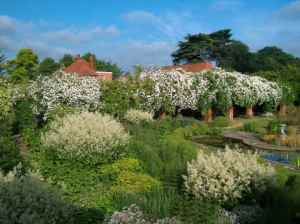
Gerritsen was pretty unique. From the little I’ve read of him (there’s very limited literature on the web – he’s not even included in Wikipedia) he followed his own vision and wasn’t bothered by what critics thought of him. Having studied art, history and politics, Gerritsen became truly interested in gardening after visiting the garden of celebrated Dutch landscape designer Mien Ruys in 1976. Later, he took on his partner’s inherited garden of Priona (now an iconic Dutch Wave garden vividly displaying Gerritsen’s approach to naturalistic gardening) which he managed until his death in 2008. A creature of counter-culture, he started something that is still unravelling and developing today in the world of garden design.
Large clumps of grasses and perennials fronted by clipped box hedges is Gerritsen’s resounding design legacy, and this pattern is repeated many times at Waltham Place to great effect. Not to be missed is inside the walled garden where his much loved clipped box ‘caterpillar’ crawls between a pond and a carnival of perennials including persicarias, miscanthus and veronicastrums all competing for space with the prolifically spreading ground elder (introduced into the UK by the Romans who ate it like spinach), eagerly covering any inch of bare soil. Once again, the dynamic interplay between formality and chaos evokes music, cheer and wonder.
Gerritsen believed that the plants and the processes of life and death could only make visual sense within the confines of a garden if combined with human, random and bizarre elements. Hence strange, whimsical and drunken topiary such as headless chickens and snails with four antennae all increase the beguiling experience of these gardens.
On the other side of the pond from the caterpillar is an iconic gravel garden, dominated currently by self-sown and very tall red-stemmed cow parsley (Peucedanum verticillare), (whose silhouettes remind me of Joshua cacti in the desert), and around their ankles the gravel hosts a mix of alliums, stipa grasses and South African bulbs including various agapanthus. Here again, you see the mess of the flower borders juxtaposed by the formality of low box hedges creating that magic Gerritsen effect where order and chaos are interdependent and compliment each other.
Behind another wall a central path is flanked by a hot border including clumps of stunning telekias (tall perennial with shaggy yellow daisy-like flowers), spikes of veratrum, umbels of bronze fennel, tall, frothy aruncus, ox-eye daisies followed by swathes of loosely sown annuals and biennials such as poppies, hogweed in various guises, hollyhocks, foxgloves… and if you look closely enough you will always find ‘weeds’ mixed in underneath their skirt tails, unafraid of being pulled out..
Rumpled textures, subdued flowers and a little bit of chaos just beyond our control… Gerritsen forged a new type of garden that we might begin to appreciate and incorporate into our own perceptions of beauty. His naturalistic style was adopted and positively commercialised by his younger Dutch colleague Piet Oudolf (who has written some fantastic books on perennial/prairie planting) and has since taken the garden design world by storm. Everybody wants perennials and clipped box hedges. Bedding is oh so passé.
And. Yet. Nobody, as far as I know, has taken on Gerritsen’s deeply felt reverence for nature in the same way. It seems to me that designers have hand-picked his aesthetics without his principles. Grasses are fine. Perennials are great. But weeds? Who dares? Visit Waltham Place and see for yourself, do they work?
Visiting: Garden tours with head gardener on Wednesdays in summer only
Waltham Place website for information and directions
Photographs: Please note no photographing is allowed in the garden. I have therefore taken the liberty of using only photos I have found online in this blog.

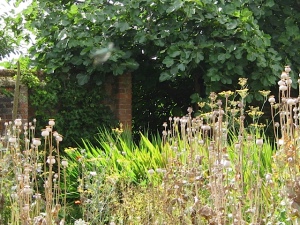



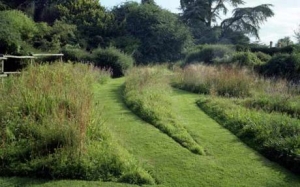
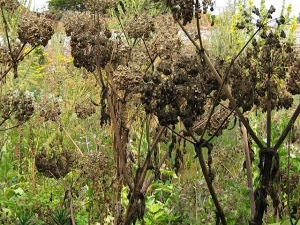

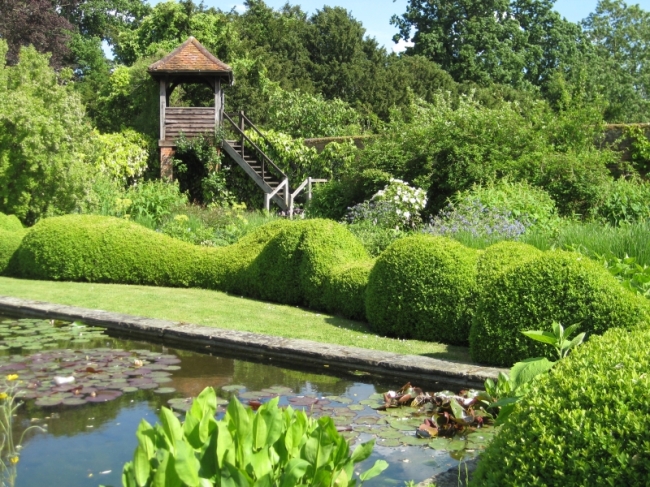


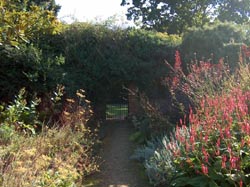

Pingback: Taxusrups | de Fruitberg